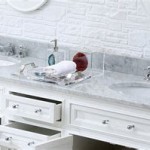How Long Should A Bathroom Vanity Be?
Determining the appropriate length for a bathroom vanity is a crucial aspect of bathroom design, influencing both the functionality and aesthetics of the space. The ideal vanity length is not a one-size-fits-all solution; rather, it depends on several factors, including the bathroom's dimensions, the number of users, storage requirements, and personal preferences. Carefully considering these elements will help ensure that the chosen vanity fits seamlessly into the bathroom, maximizing usability and creating a visually appealing environment.
Selecting the wrong vanity size can lead to various issues. A vanity that is too small might lack sufficient counter space, storage, and sink area, causing inconvenience and frustration. Conversely, a vanity that is too large could overwhelm the bathroom, making it feel cramped and restricting movement. Therefore, accurate measurements and thoughtful planning are essential to achieving a balanced and practical bathroom layout.
Assessing Bathroom Dimensions
The available space in the bathroom is the most fundamental factor in determining the appropriate vanity length. Before considering any specific vanity size, it is imperative to measure the bathroom accurately. This includes the length and width of the room, as well as the distance between fixtures such as the toilet, shower, and any existing cabinetry. These measurements provide a baseline for understanding the limitations and possibilities of the space.
When measuring, it is important to account for clearances around fixtures. Building codes and design best practices typically recommend minimum clearances for ease of use and accessibility. For example, a clear space of at least 30 inches wide should be available in front of the toilet, and a similar clearance is desirable in front of the shower or tub. The vanity should not impede these clearances, ensuring that the bathroom remains functional and comfortable.
The placement of doors and windows also plays a crucial role in determining the optimal vanity length. A vanity should not obstruct the swing of the door or block natural light from entering the room. Consider the position of these elements when planning the vanity's location. If the bathroom has a narrow layout, a longer, narrower vanity might be more suitable than a shorter, wider one. Alternatively, if the bathroom is more square, a wider vanity could provide ample counter space and storage without compromising the overall flow of the room.
For smaller bathrooms, considerations such as corner vanities or floating vanities can maximize space utilization. Corner vanities fit neatly into a corner, freeing up valuable floor space. Floating vanities, mounted to the wall without legs, create a sense of openness and make the room feel larger. These options can be particularly beneficial in compact bathrooms where every inch counts.
Considering User Needs and Storage Requirements
The number of people who will regularly use the bathroom is a significant factor in determining the appropriate vanity length. In a master bathroom shared by two individuals, a longer vanity with multiple sinks and ample counter space is often desirable. This allows each person to have their own designated area for grooming and storage, reducing conflicts and improving the overall bathroom experience.
For guest bathrooms or powder rooms, where the vanity is primarily used for handwashing and quick touch-ups, a shorter vanity may suffice. A single sink and minimal counter space are often adequate in these spaces. However, even in a small bathroom, it is important to consider the need for basic storage. Even a small vanity can incorporate drawers or shelves to accommodate toiletries, hand towels, and other essentials.
Storage requirements should be carefully assessed when determining the vanity length. Consider the types of items that will be stored in the vanity, such as toiletries, cleaning supplies, towels, and personal care products. If a large amount of storage is needed, a longer vanity with multiple drawers, shelves, or cabinets will be necessary. It is also possible to incorporate storage solutions within the vanity, such as pull-out organizers, drawer dividers, and adjustable shelves, to maximize the available space.
The layout of the storage space within the vanity should also be considered. Drawers are ideal for storing smaller items, such as makeup, hair accessories, and toiletries. Cabinets are better suited for larger items, such as cleaning supplies, towels, and spare toilet paper. A combination of drawers and cabinets can provide the most versatile storage solution. The depth of the drawers and cabinets should be carefully considered to ensure that they can accommodate the intended items without wasting space.
Standard Vanity Sizes and Custom Options
While bathrooms come in various shapes and sizes, there are standard vanity sizes that can serve as a starting point for the selection process. These standard sizes provide a range of options to suit different bathroom dimensions and user needs. Understanding these standard sizes can help narrow down the choices and streamline the decision-making process.
The most common vanity widths are 24 inches, 30 inches, 36 inches, 48 inches, 60 inches, and 72 inches. A 24-inch vanity is typically the smallest option and is suitable for very small bathrooms or powder rooms. A 30-inch or 36-inch vanity is a good choice for small to medium-sized bathrooms with a single user. A 48-inch vanity provides ample counter space and storage for a shared bathroom. A 60-inch or 72-inch vanity is ideal for larger master bathrooms with multiple users, offering plenty of space for two sinks and extensive storage.
In addition to width, the depth and height of the vanity are also important considerations. Standard vanity depths typically range from 18 inches to 24 inches. A shallower vanity may be preferable in a small bathroom to maximize space. Standard vanity heights usually range from 30 inches to 36 inches. Taller vanities are becoming increasingly popular, as they offer a more comfortable working height for many individuals. The height of the vanity should be chosen based on the user's height and personal preferences.
While standard vanity sizes are readily available and often more affordable, custom vanities offer the flexibility to create a truly unique and personalized bathroom design. A custom vanity can be built to specific dimensions, ensuring a perfect fit for the available space. Custom vanities also allow for the selection of specific materials, finishes, and hardware, creating a cohesive and stylish look that complements the overall bathroom decor.
When considering a custom vanity, it is important to work with a skilled and experienced cabinet maker or interior designer. They can provide guidance on design options, material selection, and construction techniques. A custom vanity can be a significant investment, but it can also be a worthwhile one, adding value and functionality to the bathroom.
Ultimately, determining the ideal length for a bathroom vanity involves a careful assessment of bathroom dimensions, user needs, and storage requirements. By considering these factors and understanding the available options, it is possible to select a vanity that enhances the functionality and aesthetics of the bathroom, creating a space that is both practical and visually appealing.

What Is The Standard Bathroom Vanity Height Size Guide

What Is The Standard Height Of A Bathroom Vanity

How To Choose Your Bathroom Vanity Height

What Height Is Right Comfort Bathroom Vanities Reach 36 Tall Swita Cabinetry With Sink Wausau

Learn Rules For Bathroom Design And Code Fix Com
How To Measure A Vanity Sink Bathroom Dimensions Standard Size Vevano

Bathroom Essentials Right Heights For Vanities Mirrors More Houzz

What Is The Standard Bathroom Vanity Height Size Guide

The Right Height For Your Bathroom Sinks Mirrors And More

What Is The Standard Height Of A Bathroom Vanity Badeloft
Related Posts







